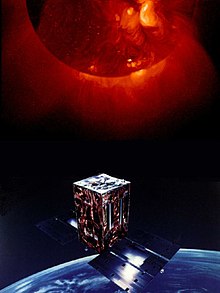Loading AI tools
Japanese spacecraft From Wikipedia, the free encyclopedia
Yohkoh (Japanese: ようこう, 'Sunbeam'), known before launch as Solar-A, was a Solar observatory spacecraft of the Institute of Space and Astronautical Science (Japan), in collaboration with space agencies in the United States and the United Kingdom. It was launched into Earth orbit on August 30, 1991 by the M-3SII rocket from Kagoshima Space Center. It took its first soft X-ray image on 13 September 1991, 21:53:40,[1] and movie representations of the X-ray corona over 1991-2001 are available at the Yohkoh Legacy site.
 Artist concept of the Japanese Yohkoh spacecraft | |
| Names | Solar-A (before launch |
|---|---|
| Mission type | Heliophysics |
| Operator | ISAS / NASA / PPARC |
| COSPAR ID | 1991-062A |
| SATCAT no. | 21694 |
| Website | Yohkoh home page |
| Mission duration | 10 years, 3 months and 14 days (achieved) |
| Spacecraft properties | |
| Launch mass | 390 kilograms (860 lb) |
| Dimensions | 2 m (6 ft 7 in) x 2 m (6 ft 7 in) x 4 m (13 ft) |
| Start of mission | |
| Launch date | 02:30, 30 August 1991 (UTC) |
| Rocket | Mu-3S-II |
| Launch site | Kagoshima M1 |
| End of mission | |
| Disposal | Spacecraft lost accidentally |
| Last contact | 14 December 2001 |
| Decay date | 12 September 2005 |
| Orbital parameters | |
| Reference system | Geocentric |
| Perigee altitude | 516 kilometres (321 mi) |
| Apogee altitude | 754 kilometres (469 mi) |
| Inclination | 31.3° |
| Period | 97.4 min |
The satellite was three-axis stabilized and in a near-circular orbit. It carried four instruments: a Soft X-ray Telescope (SXT), a Hard X-ray Telescope (HXT), a Bragg Crystal Spectrometer (BCS), and a Wide Band Spectrometer (WBS). About 50 MB were generated each day and stored on board by a 10.5 MB bubble memory recorder.
Because SXT utilized a charge-coupled device (CCD) as its readout device, perhaps being the first X-ray astronomical telescope to do so, its "data cube" of images was both extensive and convenient, and it revealed much interesting detail about the behavior of the solar corona. Previous solar soft X-ray observations, such as those of Skylab, had been restricted to film as a readout device. Yohkoh therefore returned many novel scientific results, especially regarding solar flares and other forms of magnetic activity.[2]
The mission ended after more than ten years of successful observation when it went into its "safehold" mode during an annular eclipse on 14 December 2001, 20:58:33 and the spacecraft lost lock on the Sun. Operational mistakes and other flaws combined in such a way that its solar panels could no longer charge the batteries, which drained irreversibly; several other solar eclipses had successfully been observed.[citation needed]
On 12 September 2005, the spacecraft burned up during reentry over South Asia. The time of reentry, as provided by the U.S. Space Surveillance Network, was 6:16 pm Japan Standard Time (JST).[citation needed]
Yohkoh carried four instruments :[3]
The CCD was 1024×1024 pixels with pixel angular size of 2.45″×2.45″, a point-spread function (core width FWHM) of about 1.5 pixels (i.e. 3.7″), a field of view of 42′×42′, which was a little larger than the whole solar disk. Typical time resolution was 2 s in flare mode and 8 s in quiet (no flare) mode, the maximum time resolution in 0.5 s.
For spectral discrimination, SXT employed wide-band filters installed on a filter wheel. There were five usable filter positions: 1265 Å-thick Al filter (2.5 Å–36 Å pass band), Al/Mg/Mn filter (2.4 Å–32 Å), 2.52 μm Mg filter (2.4 Å–23 Å), 11.6 μm Al filter (2.4 Å–13 Å), 119 μm Be filter (2.3 Å–10 Å). Before the entrance filter failure in November 1992 three more filter positions were available: no analysis filter (2.5 Å–46 Å), Wide band optical filter (4600 Å–4800 Å), Narrow band optical filter (4290 Å–4320 Å).
Seamless Wikipedia browsing. On steroids.
Every time you click a link to Wikipedia, Wiktionary or Wikiquote in your browser's search results, it will show the modern Wikiwand interface.
Wikiwand extension is a five stars, simple, with minimum permission required to keep your browsing private, safe and transparent.